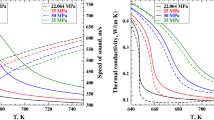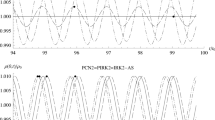Abstract
The laminar breakdown of the boundary-layer flow of an axisymmetric sharp cone in a Mach 8 flow is simulated by a synergistic approach that combines the parabolized stability equation (PSE) method and spatial direct numerical simulation (DNS). The transitional state is triggered by a symmetric pair of oblique second-mode disturbances whose nonlinear interactions generate strong streamwise vorticity, which leads in turn to severe spanwise variations in the flow and eventual laminar breakdown. The PSE method is used to compute the weakly and moderately nonlinear initial stages of the transition process and, thereby, to derive a harmonically rich inflow condition for the DNS. The strongly nonlinear and laminar-breakdown stages of transition are then computed by well-resolved DNS, with a highly accurate algorithm that exploits spectral collocation and high-order compact-difference methods. Evolution of the flow is presented in terms of modal energies, mean quantities (e.g., skin friction), Reynolds stresses, turbulent kinetic energy, and flow visualization. The numerical test case is an approximate computational analog of one of the few stability experiments performed for hypersonic boundary-layer flows. Comparisons and contrasts are drawn between the experimental and the computational results. “Rope-like” waves similar to those observed in schlieren images of high-speed transitional flows are also observed in the numerical experiment and are shown to be visual manifestations of second-mode instability waves.
Similar content being viewed by others
References
Adams, N.A., and Kleiser, L. (1993). Numerical simulation of transition in a compressible flat-plate boundary layer. In Transitional and Turbulent Compressible Flows—1993 (L.D. Kral and T.A. Zang, eds.). FED, Vol. 151. ASME, New York, pp. 101–110.
Ames Research Staff (1965). Equations, tables, and charts for compressible flow. Technical report, NACA TR 1135.
Bertolotti, F., and Herbert, T. (1991). Analysis of the linear stability of compressible boundary layers using the PSE. Theoret. Comput. Fluid Dynamics, Vol. 3, No. 2, pp. 117–124.
Bertolotti, F.P., Herbert, T., and Spalart, P.R. (1992). Linear and nonlinear stability of the Blasius boundary layer. J. Fluid Mech., Vol. 242, pp. 441–474.
Carpenter, M.H., Gottlieb, D., and Abarbanel, S. (1993). The stability of numerical boundary treatments for compact high-order finite-difference schemes. J. Comput. Phys., Vol. 108, No. 2, pp. 272–295.
Chang, C.-L., and Malik, M.R. (1993). Non-parallel stability of compressible boundary layers. AIAA Paper 93-2912.
Chang, C.-L., and Malik, M.R. (1994). Oblique mode breakdown in supersonic boundary layers using PSE. J. Fluid Mech. (to appear).
Chang, C.-L., Malik, M.R., Erlebacher, G., and Hussaini, M.Y. (1991). Compressible stability of growing boundary layers using parabolized stability equations. AIAA Paper 91-1636.
Demetriades, A. (1958). An experimental investigation of the stability of the laminar hypersonic boundary layer. Technical report, GALCIT Hypersonic Research Project, Memorandum No. 43.
Demetriades, A. (1960). An experiment of the stability of hypersonic boundary layers. J. Fluid Mech., Vol. 7, No. 3.
Demetriades, A. (1977). Boundary layer instability observations at Mach number 7. J. Appl. Mech. ASME, Vol. 99, No. 1, pp. 7–10.
Demetriades, A. (1978). New experiments on hypersonic boundary layer stability including wall temperature effects. In Proceedings of the 1978 Heat Transfer and Fluid Mechanics Institute (C.T. Crowe and W.L. Grosshandler, eds.). Stanford University Press, Stanford, CA, pp. 39–54.
Dinavahi, S.P.G., Pruett, C.D., and Zang, T.A. (1994). Direct numerical simulations and data analysis of a Mach 4.5 transitional boundary-layer flow. Phys. Fluids A, Vol. 6, No. 3, pp. 1323–1330.
Don, W.S. (1994). Numerical study of pseudospectral methods in shock wave applications. J. Comput. Phys., Vol. 110, pp. 103–111.
Erlebacher, G., and Hussaini, M.Y. (1991) Nonlinear evolution of a second-mode wave in supersonic boundary layers. Appl. Numer. Math., Vol. 7, pp. 73–91.
Fasel, H., Thumm, A., and Bestek, H. (1993). Direct numerical simulation of transition in supersonic boundary layers: Oblique breakdown. In Transitional and Turbulent Compressible Flows—1993 (L.D. Kral and T.A. Zang, eds.). FED, Vol. 151. ASME, New York, pp. 77–92.
Gottlieb, D., Hussaini, M.Y., and Orszag, S.A. (1984). Introduction: Theory and applications of spectral methods. In Spectral Methods for Partial Differential Equations (R.G. Voigt, D. Gottlieb, and M.Y. Hussaini, eds.). SIAM, Philadelphia, PA, pp. 1–54.
Guo, Y., Adams, N.A., and Kleiser, L. (1995). Modeling of nonparallel effects in temporal direct numerical simulations of compressible boundary-layer transition. Theoret. Comput. Fluid Dynamics, Vol. 7, No. 2, pp. 141–157.
Havener, G. (1994). Computational flow imaging: Fundamentals and history. AIAA Paper 94-2615.
Herbert, T. (1988). Secondary instability of boundary layers. Ann. Rev. Fluid Mech., Vol. 20, pp. 487–526.
Kendall, J.M. (1967). Supersonic boundary layer stability experiments. In Proceedings of Boundary Layer Transition Study Group Meeting, Vol. II. Aerospace Corporation.
Kendall, J.M. (1975). Wind tunnel experiments relating to supersonic and hypersonic boundary layer transition. AIAA J., Vol. 13, No. 3, pp. 290–299.
Kloker, M.J. (1993). Direkte numerische Simulation des laminar-turbulenten Stroemungsumschlages in einer strak verzoegerten Grenzshict. Ph.D. thesis, Universitaet Stuttgart.
Lele, S.K. (1992). Compact finite difference schemes with spectral-like resolution. J. Comput. Phys., Vol. 103, pp. 16–42.
Mack, L.M. (1984). Boundary-layer linear stability theory. In Special Course on Stability and Transition of Laminar Flow (R. Michel, ed.). AGARD Report No. 709, pp. 3.1–3.81.
Malik, M.R., Spall, R.E., and Chang, C.-L. (1990). Effect of nose bluntness on boundary layer stability and transition. AIAA Paper 90-0112.
Masad, J.A. (1993). Relationship between transition and modes of instability in supersonic boundary layers. Technical report, NASA Contractor Report 4562.
Pruett, C.D. (1993). On the accurate prediction of the wall-normal velocity in compressible boundary-layer flow. Internat. J. Numer. Methods Fluids, Vol. 16, 1993, pp. 133–152.
Pruett, C.D., and Chang, C.-L. (1993). A comparison of PSE and DNS for high-speed boundary-layer flows. In Transitional and Turbulent Compressible Flows—1993 (L.D. Kral and T.A. Zang, eds.). FED, Vol 151, ASME, New York, pp. 57–67.
Pruett, C.D., and Streett, C.L. (1991) A spectral collocation method for compressible, non-similar boundary layers. Internat. J. Numer. Methods Fluids, Vol. 13, No. 6, pp. 713–737.
Pruett, C.D., and Zang, T.A. Direct numerical simulation of laminar breakdown in high-speed, axisymmetric boundary layers. Theoret. Comput. Fluid Dynamics, Vol. 3, No. 6, pp. 345–367.
Pruett, C.D., Ng, L.L., and Erlebacher, G. (1991). On the nonlinear stability of a high-speed axisymmetric boundary layer. Phys. Fluids A, Vol. 3, No. 12, pp. 2910–2926.
Pruett, C.D., Ng L.L., and Erlebacher, G. (1992). On the non-uniqueness of the parallel-flow approximation. In Instability, Transition, and Turbulence (M.Y. Hussaini, A. Kumar, and C.L. Streett, eds.). Springer-Verlag, New York, pp. 344–355.
Pruett, C.D., Zang, T.A., Chang, C.-L., and Carpenter, M.H. (1995). Spatial direct numerical simulation of high-speed boundary-layer flows—part I: Algorithmic considerations and validation. Theoret. Comput. Fluid Dynamics, Vol. 7, No. 1, pp. 49–76.
Schmid, P., Lundbladh, A., and Henningson, D.S. (1994). Spatial evolution of disturbances in plane poiseuille flow. In Proceedings of the ICASE/LaRC Workshop on Transition, Turbulence, and Combustion (M.Y. Hussaini, T.L. Jackson, and T.B. Gatski (in press).
Simen, M. (1993). Lokale und nichtlokale Instabilitaet hypersonischer Grenzschictstroemungen. Technical report DLR-FB 93-31, Deutsche Forschungsanstalt fuer Luft- und Raumfahrt, Institut fuer Theoretische Sroemungsmechanik, Goettingen.
Smith, L.G. (1994). Pulsed-laser schlieren visualization of hypersonic boundary-layer instability waves. AIAA Paper 94-2639.
Stetson, K.F., and Kimmel, R.L. (1992). On hypersonic boundary-layer stability. AIAA Paper 92-0737.
Stetson, K.F., and Kimmel, R.L. (1993). On the breakdown of a hypersonic laminar boundary layer. AIAA Paper 93-0896.
Stetson, K.F., Thompson E.R., Donaldson, J.C., and Siler, L.G. (1993). Laminar boundary layer stability experiments on a cone at Mach 8. Part 1: Sharp cone. AIAA Paper 83-1761.
Streett, C.L., and Macaraeg, M.G. (1989/90). Spectral multi-domain for large-scale fluid dynamic simulations. Appl. Numer. Math., Vol. 6, pp. 123–139.
Tadmor, E. (1989). Convergence of spectral methods for nonlinear conservation laws. SINUM, Vol. 26, pp. 30–44.
Thompson, K.W. (1987). Time dependent boundary conditions for hyperbolic systems. J. Comput. Phys., Vol. 68, pp. 1–24.
Wendt, V., Kreplin, H., Hoehler, G., Grosche, F., Krogmann, P., and Simen, M. (1993). Planar and conical boundary layer stability experiments at Mach 5. AIAA Paper 93-5112.
Wilkinson, S.P., and Anders, S.G. (1994). Instability and transition on a conical model with adverse pressure gradient in a quiet hypersonic wind tunnel. Technical report, NASA TP (in preparation).
Williamson, J.H. (1980). Low-storage Runge-Kutta schemes. J. Comput. Phys., Vol. 35, pp. 48–56.
Zang, T.A., Krist, S.E., and Hussaini, M.Y. (1989). Resolution requirements for numerical simulations of transition. J. Sci. Comput., Vol. 4, No. 2, pp. 197–217.
Author information
Authors and Affiliations
Additional information
Communicated by M.Y. Hussaini
This research was supported under NASA Contracts NAS1-19831 and NAS1-20059 for the first and second authors, respectively.
Rights and permissions
About this article
Cite this article
Pruett, C.D., Chang, CL. Spatial direct numerical simulation of high-speed boundary-layer flows Part II: Transition on a cone in Mach 8 flow. Theoret. Comput. Fluid Dynamics 7, 397–424 (1995). https://doi.org/10.1007/BF00312416
Received:
Accepted:
Issue Date:
DOI: https://doi.org/10.1007/BF00312416




